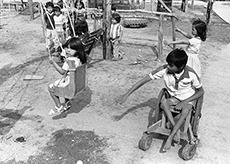Hesperian Health Guides
How Small, Local Programs Spread to New Villages and Areas
HealthWiki > Disabled Village Children > Chapter 45: Starting Village-Based Rehabilitation Activities > How Small, Local Programs Spread to New Villages and Areas
There are various ways that bottom-up or people-centered programs tend to spread. We speak of their growth as “organic” because they grow and spread in a living, whole sort of way, like seeds into trees.
In Project PROJIMO, some of the young people from neighboring communities, who first come for rehabilitation, decide to stay and to work for a while in the program. In the process they learn skills which they can use to help in the rehabilitation of other persons when they return to their own communities. In some cases, other villages and village-based health programs have sent young people with disabilities to apprentice with PROJIMO for several months, in order to help start similar activities on return to their communities.
Another people-centered program that started small and has spread to many other towns is the Community Rehabilitation Development Program in Peshawar, Pakistan.
ACTIVITIES IN THE COMMUNITY TO WIN INTEREST AND UNDERSTANDING
Group activities in a village or neighborhood can help improve understanding of and interaction with children with disabilities. Social gatherings of children with disabilities and their families are a place for these families to connect for support. Gatherings that include the larger community can help change attitudes about children with disabilities and help people become more familiar with their experiences and realities. These social gatherings can be an important first step for the four particularly useful activities discussed in the next 4 chapters:

- A “Playground for all children”
- CHILD-to-child activities
- Popular theater
- A children’s workshop for making toys
Any of these activities may be used to gain people’s interest and involvement when starting a community rehabilitation program. Or they can be used to increase understanding even where no special program is planned. For example, the workers in a village with a rehabilitation center can visit neighboring villages and put on skits or puppet shows about disability prevention. They might also talk with school teachers, local health workers or concerned parents about developing CHILD-to-child activities, or organize local children to build a “playground for all children.” Project PROJIMO took a truckload of school children to a neighboring village to help the children there build their own playground. Nearly 100 children and adults built the playground in one day.
After these 4 chapters, we will explore other aspects of social integration and opportunities for people with disabilities.


